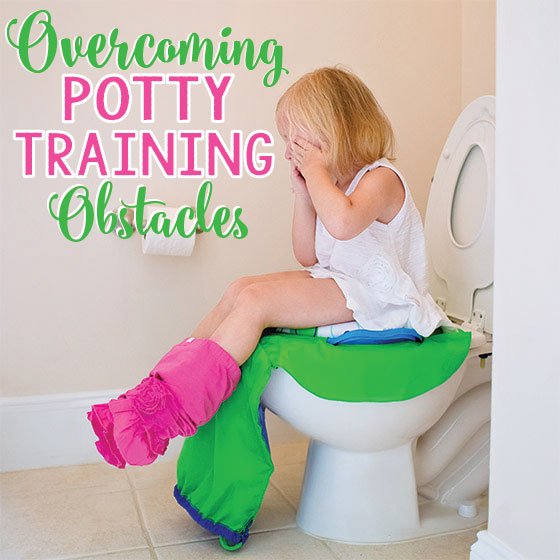It happens to the best of us. You set out on a potty training mission sometime after your child learns to walk and find that what seems like it should be fairly simple, quickly becomes one of your greatest parenting challenges.
For some children, they seem not to care that they have a wet or stinky diaper. For other kids, you’ve been hoping to follow their lead, but now it’s time to go to preschool and the school requires a potty trained child. Or maybe you’re about to have another child and want to avoid having two in diapers. Whatever the case, today we’re going to uncover the most common potty training obstacles… and how to work through them.
Rewards Don’t Work
Many parents find that reward charts or systems work brilliantly for their child when they take on potty training. The idea of getting a piece of candy each time they “make pee pee,” or earning enough stickers to shop for a prize at the store is an awesome way to reinforce positive behavior. However, it doesn’t always work and it can wear off, especially if you’ve been “training” for awhile.
We’ve found that once your child hits two or three, that is if your child doesn’t want to use the potty, they don’t care what the prize. While applauding this new sense of independence, it can be quite frustrating to hear NO yelled repeatedly at your face and no amount of time outs (or other forms of discipline) are going to change that. That frustration will only increase if you have a specific timeline in mind for your child to be potty trained.
If you’re in this situation, there are a few courses of action.
1. Consider Alternative Incentives
Don’t bother trying to up the ante. A smart and strong-willed child will play you like a fiddle if you attempt to change up the reward system by offering bigger or better toys, food, etc. You regularly hear of 3 year olds who like to negotiate terms while sitting on the potty only to avoid the actual act of pee peeing or poo pooing all together.
What if, instead, you offered the incentive of time with their best friend or the opportunity to make a celebratory phone call to grandma to share the good news of being a big girl or boy? You might even allow “big-kid” privileges to your child once they are fully trained such as a later bedtime. Think about what will motivate your child.
2. Try a Dose of Reverse Psychology
In an attempt to get our children to look at the camera and smile, we had a revelation. When you tell a child not to look at the camera or not to smile at you – they will do the exact opposite. In fact, kids love to do the opposite of what you tell them to do, so why not try this approach with the potty.
Make the potty a “forbidden fruit.” Tell your child that whatever they do, do not use that potty. You could even create a game of it. For example, if your child really likes the idea of being a big girl, tell her that you don’t want her to use the potty because then she’d be a big girl and you want her to be your little baby forever.
Another example is if you are planning to take your child to Disney World or Disneyland soon, you could tell your son or daughter that Disney called and wants them to be a princess/pirate/”insert their favorite character,” but that they only take potty-trained boys and girls. See how quickly your child shows interest in the potty then!
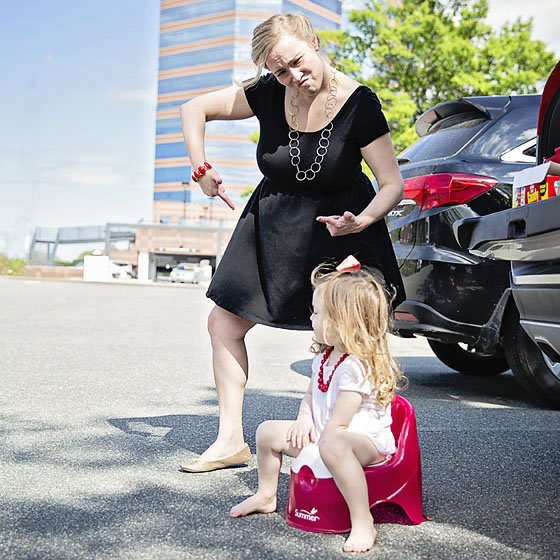
3. Join the fun!
Some kids are motivated to do anything they see other people doing; especially if those people are family. If you have an older child, this may make potty training easier as the younger child will want to be just like their big brother or sister. However, if you are potty training your only (or older) child, you may need to become a more enthusiastic role model.
Just as you might clap or dance when your child goes to the potty, celebrate with the same level of gusto when you use the potty yourself. If necessary, you can even set up a reward jar for yourself as suggested by Teri Crane in her book, Potty Train Your Child in Just One Day. It might feel a little ridiculous, but we bet it’s not the first time you’ve done something a little silly for the sake of your child.
Making the Transition into Underwear
The bare-bottom approach to potty training is a popular and effective technique, but for some children, making the transition from naked booty to big-kid undies can be quite a challenge.
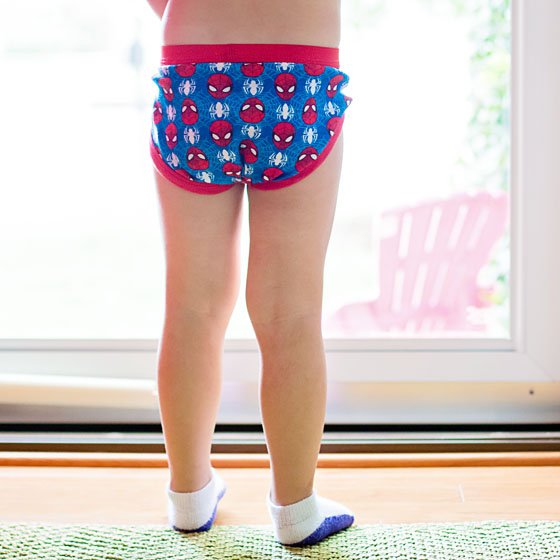
- Take your kid shopping for new undies. Some kids are more apt to keep their underwear dry and clean if they picked them out. While you might think a pair of princess panties will make for a smooth transition into big girl panties, you may be surprised to learn that she’d prefer a pair of boy’s Spider Man undies.
- Once your child is consistently going to the potty using the bare-bottomed approach, continue to stay close to home in undies. Encourage your child to pull their underwear up and down often – even if they don’t need to go potty. They’ll need to know this skill set for many preschool and daycare programs, so you might as well practice now, at home.
- Throw away dirty undies. While we realize that you can easily wash out a dirty pair of underwear, if your child really likes their new underwear, to throw away their beloved undies might be just enough to prevent future accidents.
- Use pull-ups over your child’s underwear if you go out of the house. Some people prefer to get rid of all diapers once they decide to potty train. That can backfire though, and you may find yourself cleaning up and changing clothes a lot. For a while, even the feeling of underwear can cause your child to pee in their pants. However, when you add a pull-up OVER the underwear, they will stay dry and you no longer have pee all over your floor and car.
A case of the hidden dirty undies
Don’t be surprised if once your child has transitioned into underwear that they have accidents. While some children will be quick to tell you that they’ve had an accident, others may be a little embarrassed and hide the evidence. In particular, some children have been known to hide a pair of stinky underwear in the hopes that you won’t discover that they’ve pooped in their pants.
Rather than just cleaning up the mess, make sure that you let your child know when you find their hidden treasure. Tell them that it’s okay to have an accident, but that they need to tell you when they do. Your child will be less apt to hide their dirty undies if they know you won’t be mad at them.
Only the Home Potty Will Do
You’ve spent weeks or months getting your child comfortable going to the potty at home with much success, but the idea of “going” anywhere else is just too much.
Kids have a tendency to get comfortable doing an activity a certain way (don’t we all), so you can understand why they wouldn’t want to sit their butt on just any old toilet; especially with all the strange noises, smells and strangers that come with public restrooms. Some will hold it until they get home, while others may not be able to make it that long. Here’s how you tackle it:
Make Every Potty Feel Like Home
A common thing you hear from children is that they “don’t wanna fall into the potty.” At home, you can overcome this fear by using child-size potties or installing child inserts into your adult-sized toilet seats. When you’re out and about, you can get a travel potty.
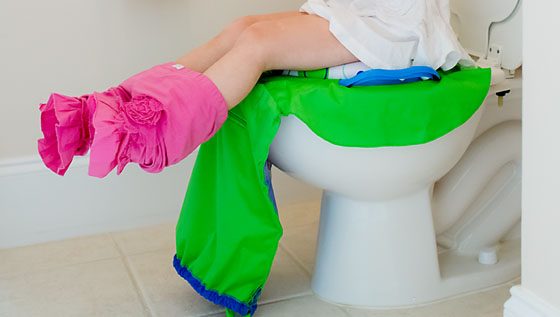
We’ve found that a travel potty seat such as Pack n Potty is a must-have for potty training toddlers and small children using public restrooms. Whether you’re running errands, out for dinner or visiting family over the holidays, you can always have a familiar place for your child to use the potty. To make your child’s potty even more familiar, you can let your kid customize their potty with stickers.
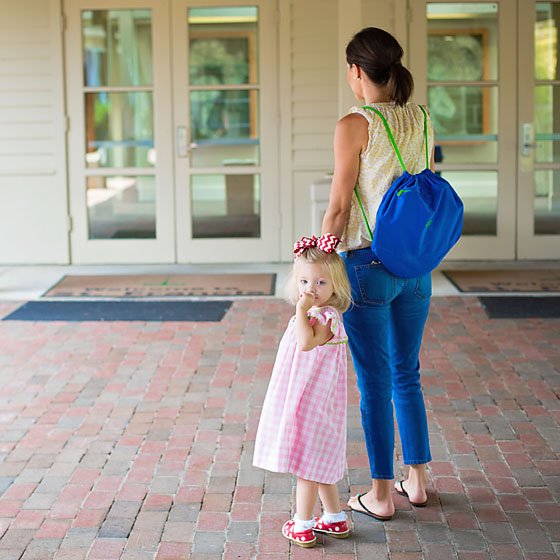
But just having a travel potty isn’t enough. It’s important to practice using it at home first. Your child can test out their new travel potty on the toilet at home to make sure it “works” before taking it on the road. Then, once your child is used to going using their new travel potty seat, they should have little to no problem going to the bathroom in unfamiliar territory.
Pack n Potty is unique from other travel potties in that it includes everything you need in a quick and ready to use tote bag. No more need to hover or line the toilet seat with toilet paper. You simply pull the Pack ‘n Potty out and use it.
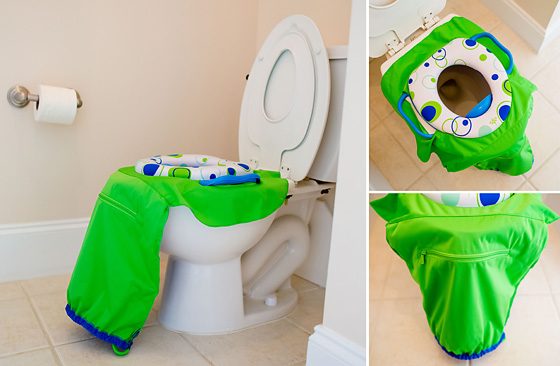
Features You Will LOVE
- Stylish, lightweight tote that converts into a full sanitary cover that covers the entire top surface of a standard toilet
- Sanitary cover is attached to a stable, child-sized potty seat, giving a child confidence and a familiar potty seat
- Unique wet/dry pocket
- Load from the outside of the tote bag and access from the inside pocket while in use
- Made of antimicrobial and waterproof material
- Machine washable and dryer safe when potty seat is removed
- Ages 18 months+
Bathroom Adventure
Public restrooms are scary places for kids that are already a little skeptical of peeing in an unfamiliar potty, but if you can turn the idea of going to the potty into an adventure, they may be curious to give it a try. Try to ignore all the germs crawling all over the place while you allow your child to count the number of stalls, listen to the flusher or test out the sink. Furthermore, if you convince your child that going to the restroom is a big kid privilege, they may want to go.
Post-It Notes
As if public restrooms weren’t scary enough, self-flushing toilets can increase a child’s fear of going to the potty in public. Not only are they loud, but the self-flusher has a mind of its own and will flush at will. To avoid this problem, try placing a Post-it note over the electric eye until your child has done their business. Once they are headed out of the stall, you can pull off the note and flush. If you want to get crafty, you can have your child add some art to the post-it note.
Potty at Preschool (or Daycare)
On a similar note, your child must learn how to use the potty without your assistance at preschool or daycare. For little girls, that means wiping themselves; for little boys, that means standing up.
When your child shows interest in learning to use the potty, make sure you discuss this with your daycare provider or preschool teacher. Really, anyone caring for your child when you are not around needs to know when your child is beginning to use the potty. A daycare provider or preschool teacher can be a wonderful resource for help with potty training because he or she has been through the process with so many children. Make sure your potty training techniques are complementary with one another, and keep the communication open so you know what is happening with potty time at school and the teacher knows what is happening at home.
A common issue that can arise at preschool or daycare is your child having accidents because he forgets to ask to go to the potty. This happens because he gets distracted with all the activity in the school environment and just keeps on playing and learning without stopping for a potty break. Talk with your childs teacher and see if you can come up with a couple times during the day to offer a potty break since your child isnt remembering to ask for one.
While it is helpful to offer a trip to the potty, try not to force your toddler to go potty. If children arent allowed to decide when they want to go, they never really learn what it feels like for their bladder to feel so full that they have to go. According to the owner and Principal of a Montessori school, this is a big problem preschool aged children have in school during the day. Going to the potty should be a natural occurrence for your child at home and at school.
Learning to Pee Standing Up
At some point, your childs school will expect boys to stand up when urinating. In fact, elementary schools have child size urinals available for boys to use. Many boys are potty trained sitting down at first and the transition to standing can be a new potty training challenge that parents might not expect. If you have to teach your son to pee standing up for school, here are some tips:
Let Dad lead the way
Your son will learn this technique best from his father or another close male figure in his life. Let him watch his dad stand up at the potty and then have Dad teach him the technique necessary to get the pee pee in the potty and not spray it all over the bathroom.
Use a Urinal
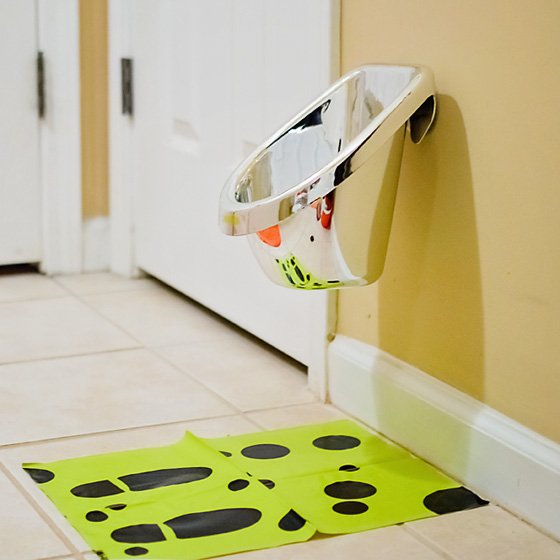
A full size toilet is too high and too large of a target for a toddler. Balancing on a stool in front of the toilet can be tricky, leading to a very messy bathroom. We love this WeePot Super Stylish Urinal for Boys. It can be affixed to any wall and set to the perfect height for your son. Once he does his business, it is easy to empty and clean for the next time. You will minimize the mess made because he can stand right up to it and it comes with a little mat to protect the floor underneath.
Since your son is likely going to be using a urinal at school, it is so valuable for him to practice using one at home. Finally, if your son is reluctant to start standing up at the potty, the WeePot urinal is exciting enough to get him started. He will be going like a big kid and ready for school in no time.
Give Him a Target

Little boys love to pretend to shoot things! Use that love to get your son aiming when he goes potty. The WeePot Urinal comes with a little bullseye sticker to aim toward. If you choose not to train your son with a urinal at home, throw a single square of toilet paper in for him to aim toward, or to make it even more exciting, drop a couple Cheerios in the potty and tell him to sink them. Not only will the target technique get your son excited about standing up, it will minimize your clean up time afterwards. A win for everyone!
Avoid the Great Outdoors
It can be tempting to teach your son to pee standing up by encouraging him to go outside. You don’t have a messy bathroom to worry about, and like some of the other tips above, it will probably be fun for him. However, this might not be the best idea for a toddler because toddlers tend to do things they enjoy over and over again and toddlers are not aware of social boundaries.
He won’t know the difference between peeing in your private backyard and peeing at the playground at school or next to the elephant enclosure at the zoo. Unless your toddler readily dropping his drawers in public is something you want to deal with, keep the potty training indoors!
Reserving No. 2 for the Diaper
Most kids will quickly catch onto the concept of peeing in the potty, but will refuse to poop in the potty. For whatever reason, pooping in the potty is a bit scary, or your child is simply having too much fun to take a break from playing to sit still on the potty long enough to “let it go.” As a result, kids revert back to what is most comfortable and familiar – a diaper. So what do you do?
Is Constipation to blame?
When some children start potty training, they refrain from pooping by holding it. On the one hand, you don’t have to worry about your child pooping in public, but it also means that they can become horribly constipated. When they do try to pass the stool, they can be in so much pain that they can become even more resistant to poop the next time.
If constipation is a problem for your child, it’s time to load them up with lots of high-fiber foods such as beans, fruits, vegetables, and whole-grain pastas and breads. You’ll also want to avoid cheese and bananas, which can make constipation even worse. If your child is a picky eater, they may or may not be willing to eat the most poop-friendly foods. Try adding a half-capful of Miralax in your child’s apple juice in the morning. If that still doesn’t work, talk to your pediatrician.

One Step at a Time
Potty training has to be tackled in stages and going No. 2 in the toilet is just another step in the process. Pediatricians suggest that you break up the process even further by taking small steps towards the potty. Consider this approach:
- Step 1: Focus on peeing on the potty and wearing underwear. If your child asks for a diaper to poop in, give them one.
- Step 2: Instead of just cleaning up the diaper and throwing it away, dump the poop into the toilet. Wave goodbye and have your child flush.
- Step 3: Encourage your child to poop on the potty wearing a diaper. They’ll have the security of their diaper, but you retrain their brain as to where the act of going No. 2 needs to happen. Instead of hiding to do their business, they will start to go to the potty. You can start by using their smaller potty chair and work your way up to the big potty.
- Step 4: Your child poops on the potty.
Establish a Routine
If you find that your child is consistently pooping at the same time, you can also help your child change their routine.
For example, many adults will wake up, eat breakfast, have a cup of coffee and use the bathroom. The same sort of routine can be done with children. Tell your child that they can be just like mommy and daddy – wake up, eat breakfast, then sit on the potty. Have them sit on the potty for 10 minutes each morning as part of their routine. If they “go,” great. If not, don’t make a big deal out of it. However, once they do make poo poo in the potty, go nuts!
Potty Training Regression
With the introduction of a new sibling, moving to a new house or even a weekend away, you may find that your potty-trained child takes a few steps back. Don’t fret – setbacks are completely normal.
Revisit Original Potty Training Approach
Rather than trying to diagnose the problem and change your approach, just go back to using whatever worked with your child to begin with. If that means going back to 2 hour reminders or using the little potty, so be it. Chances are that this temporary set-back is just that – temporary.

Let Your Child Have Control
Our kids can sense when we want something to happen and the tension may be way too much. So, try not to care so much when you hit a regression. Remember that potty training is a process, and while the end goal is great (yay, no diapers), getting to the finish line takes time. By allowing your child to lead the way, you may find that everything works its way out in a much less stressful way.
With all that said, best of luck to you as you and your child take this next step towards being a big kid. Potty training isn’t for the faint of heart, but you’ve got this!
If you are having trouble with your child not pooping, read our article on poop withholding
Photo Credits: Ashley Sisk, Dani, Kristen Douglas, Donnie Ray Jones (photo cropped)








































